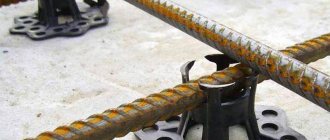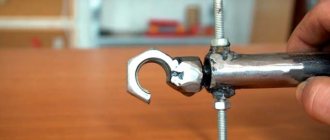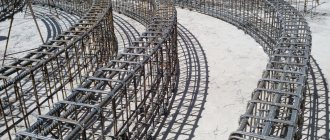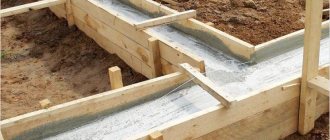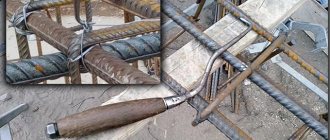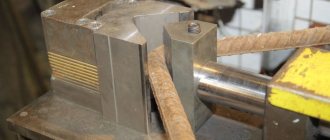The characteristics of the concrete base depend on the quality of the reinforcement. Uniform installation within a concrete structure increases reliability. The layer of concrete increases, protecting the reinforcing mesh from rust; a level installation assumes an even distribution of the load over the surface. A reinforcement clamp will help you cope. Keeps the metal structure at a distance from the formwork.
Stand for fittings
Tasks of clamps
The task of the products is to maintain the correct position of the reinforcement cage in relation to the base. They are for one-time use. After pouring the concrete, they remain inside the base. The material should be inexpensive. Thanks to proper installation, the process of pouring the solution is accelerated several times.
Features, Benefits
During reinforcement, additional parts are used - stands for attaching metal rods. They are made of plastic and are called retainers. They have good technical performance and are in demand:
- Eco-friendly.
- Withstands exposure to ultraviolet rays and low temperatures.
- Inert to alkaline, aggressive environments.
- Versatile.
An important point is that they can be used for any type of concrete base.
Purpose - to provide gaps between the surface of concrete and the reinforcing frame. Advantages:
- Possibility of filling with mortar, part of the structure will not budge.
- It is possible to maintain the distance from the surface to the reinforcing frame; the metal is not subject to corrosive damage.
- Plastic products provide stability to the reinforcement frame.
- It is possible to increase the service life of metal products.
Classification, limits of application
Reinforcing structure fasteners can be used in several structures:
- When forming floor slabs.
- For the construction of walls.
- While pouring the foundation.
When creating a columnar, bored foundation, star-shaped fixing elements are used. The structure is a mesh element through which the concrete mixture flows freely.
When installing horizontal reinforcing structures, “racks” are used. It is possible to provide a protective layer thickness of 15-35 mm, with a reinforcement diameter of 19-25 mm.
If a preliminary concrete surface has been prepared, you can use a “chair”. It has good load-bearing capacity and is used when installing high-thickness monolithic slabs. Provides a protective layer of 15-60 mm, with a section diameter of 14-24 mm.
On unstable surfaces, such as crushed stone, sand cushions, “pyramid” models are used. They can withstand a concrete layer of 15-90 mm, with a reinforcement diameter of up to 16 mm.
Requirements for reinforcement clamps
When constructing buildings, the fundamental conditions for the durability of the structure are the correct installation of the supporting frame, enclosed in concrete mortar. The duration of use of the object, its safety and strength depend on the high-quality fixation of metal rods. It allows you to create the necessary protective layer of the required thickness, a given thickness between the reinforcement and the formwork panel.
The clamps are installed just before the mortar is poured into the created formwork system. Using polymer products, strong fastening of metal rods in the formwork is ensured, and the distance between the panels and the frame is maintained. This design eliminates the appearance of various defects on walls, ceilings, columns, door and window openings.
The metal frame begins at:
- laying reinforcing bars on the base;
- securing the intersection with wire.
Temporary supports can be used. It is necessary to install reinforcement clamps under all intersections of rods to ensure compliance with the technological gaps.
Types of fastenings
Manufactured from plastic, which has high strength and availability, they have good performance. Sometimes, elements taken from the formwork are used. The solution has a drawback - after pouring the concrete, the parts must be removed. The resulting cavities are filled with concrete mixture. Types of fixation elements according to the location of the reinforcement:
- Supporting. Used for horizontal structures - “cube”, “chair”.
- Wall. Used for vertical reinforced structures.
- Universal.
- Special. Necessary for the formation of a cavity in the base. This class includes tubes and plugs.
"High Chair"
Used when pouring monolithic foundations with a large load on the base surface. It can be simple, reinforced. In the second option, instead of four legs, five are used. The “chair” copes with fixing rods with a cross-section of 4-16 mm. It is possible to form a layer of concrete on top of the reinforcement frame - 15-40 mm.
High chair with stand
"Cube"
Designed for placing reinforcing inserts under the rods. According to SNiP, 6-10 products are required per 1 m2. When the product is turned over, the thickness of the protective concrete base changes. By turning the “Cube” over, you can achieve a layer thickness of up to 35-80 mm.
Cube with stand
"Cone"
Used for assembling panel formwork. A coupling screw is installed between the two shields and twisted into “cones”. Before installation, it is necessary to put on the tube included in the kit to free the threaded connection from concrete. After pouring the foundation, you can remove the threaded rod without damage (the tube remains inside).
Cone with tube
"Rack"
The “stand” looks like a “cube”. Features a cylindrical shape that can withstand heavy loads. Purpose - fixation of a reinforced frame on loose soil. It can be used with an additional element that reduces the pressure on the ground surface.
Rack
Used for fixing horizontal rods with a diameter of up to 16 mm. Creates a protective layer of 12-40 mm. Has good load-bearing abilities. When installing additional elements, it copes with the pressure load of the reinforcing structure. Consumption of products per square meter – 6-10 pcs.
"Star"
The main place for the “asterisk” is vertical structures, but they are also suitable for horizontal ones. It has a snap mechanism that securely fastens the product to the fittings. Protection layer - 15-75 mm.
Star
Fixation can be done on metal rods with a diameter of up to 22 mm. Often used when installing vertical concrete structures. One square meter of working surface will require 4-8 products.
Multi-level
Fixation of several levels is carried out. The product does not differ in appearance from simple parts, but has clamps for fastening to fittings.
Multi-level
Choice, installation features
“Stars” are popular – they are universal.
When choosing an “asterisk” as a fastening element, consider the quality of the material. Poorly made fasteners have a short service life and break into several parts upon first use.
Consider the thickness of the product and the quality of workmanship. It should be flexible and not break when pressed. A simple method is to put the part on an object corresponding to the cross-sectional diameter of the reinforcing rod. If the product has retained its integrity, it can be used when fixing reinforcing rods.
Basic requirements for fasteners for reinforcement
Must be made of durable material. The quality determines how heavy loads a concrete foundation can withstand. To check the chair and cube, just stand on them. If they remain intact, slightly deformed, this is normal.
Elements that are installed on the ground require additional parts - stands to reduce pressure.
Selection and installation features
The first criterion for choosing fasteners for fittings is the type. Popular star-type reinforcement clamps are a universal solution for fastening vertical and horizontal arrays of metal rods. This element is very demanding on the quality of the material from which it is made, since when fastened, low-quality sprockets split into several parts. Therefore, when choosing, you need to ensure that the plastic is sufficiently thick and of its quality; it must be durable and elastic.
The most reliable test is to simply put the clamp on an object of suitable diameter for the fitting. If it does not collapse, it can be used in construction.
When selecting clamps for horizontal structures, you need to check their strength, since they experience high loads. To check the “cube” and “chair” you just need to stand up these elements; under the weight they may be slightly deformed, but not burst. We must not forget that when strengthening reinforcement on the ground, the fastening parts must be equipped with additional elements - supports. They reduce the pressure of the structure and do not sink into the ground, leaving the metal above the surface. As a result, it is completely covered with the solution and does not corrode, which extends its service life.
For all types of clamps, the core diameter is important. Select by markings - FS30 for a rod of 30 mm, FS50 for a diameter of 50 mm, etc. It is important to immediately calculate the number of fasteners per linear or square meter. According to GOST, the number of these elements per m² should be in the range of 4-10 pieces. It must be taken into account that the fewer fasteners you have to use, the stronger the reinforced concrete structure will be. At the same time, their insufficient quantity will lead to a violation of the integrity of the reinforcement and a decrease in the quality of the protective layer.
What can you make your own fasteners from?
From pipe scraps
You can take a piece of plastic pipe and drill holes on the sides to install the clamp on the crosshairs of the reinforcing mesh. The fixing element can be used to hold one rod; you will have to drill not four holes, but two.
From a rod
The “frog” is installed between the reinforcing mesh to secure the top row. The product provides additional strength to the entire structure. When compared with tying a reinforcing structure onto “soldiers” (vertically installed scraps of metal rods), the method significantly speeds up installation.
Made from rod and metal rings
It looks like a “frog”, but has differences - a metal rod, which is installed in a ring of the same material, is poured with concrete. Used to secure the top floor of the reinforcing mesh. The fixing element is a ring. Reinforcing mesh is laid on it. At the bottom, a U-shaped rod is attached to the metal frame.
What fasteners should not be made from
Bad materials for parts are wood: stands made of small planks, installed pegs, multilayer plywood laid with plates, chipboard. Reasons: wood absorbs moisture very strongly and can affect the quality of concrete due to rapid drying; has poor strength, soaked in moisture, it only gets worse.
You cannot use plastic bottles; they have poor load-bearing capacity; when pouring concrete, the bottle will be crushed.
Brick is not the best option. Reasons: absorbs liquid and breaks down over time.
Choosing fasteners - advice from an expert
In my 10 years of practice in monolithic construction, I quite often encountered the problem of defective fasteners. After installing them under the reinforcing mesh, and then stepping on it, the stands simply scattered to the sides. They broke in half, and the mesh was lowered onto the formwork. There was also a case with the “star” fasteners; during installation on the reinforcing mesh, they simply flew apart, half the bag was simply thrown into the air. The problem was low-quality plastic; it was fragile.
When purchasing, I advise you to open the bag with plastic stands and check them. If it's a chair, stand on it, it shouldn't break, it might just bend. The fastener is an asterisk, try to put it on something of a suitable diameter, bend it, it should not break. Plastic must be flexible and at the same time strong. If everything is ok, buy it.
Currently, the range of fasteners for fittings is simply huge, and every year it is growing all the time. New companies, new forms appear, but their goal remains the same, which is to provide the necessary protective layer to the reinforcement so that the structure you are building is strong and reliable.

